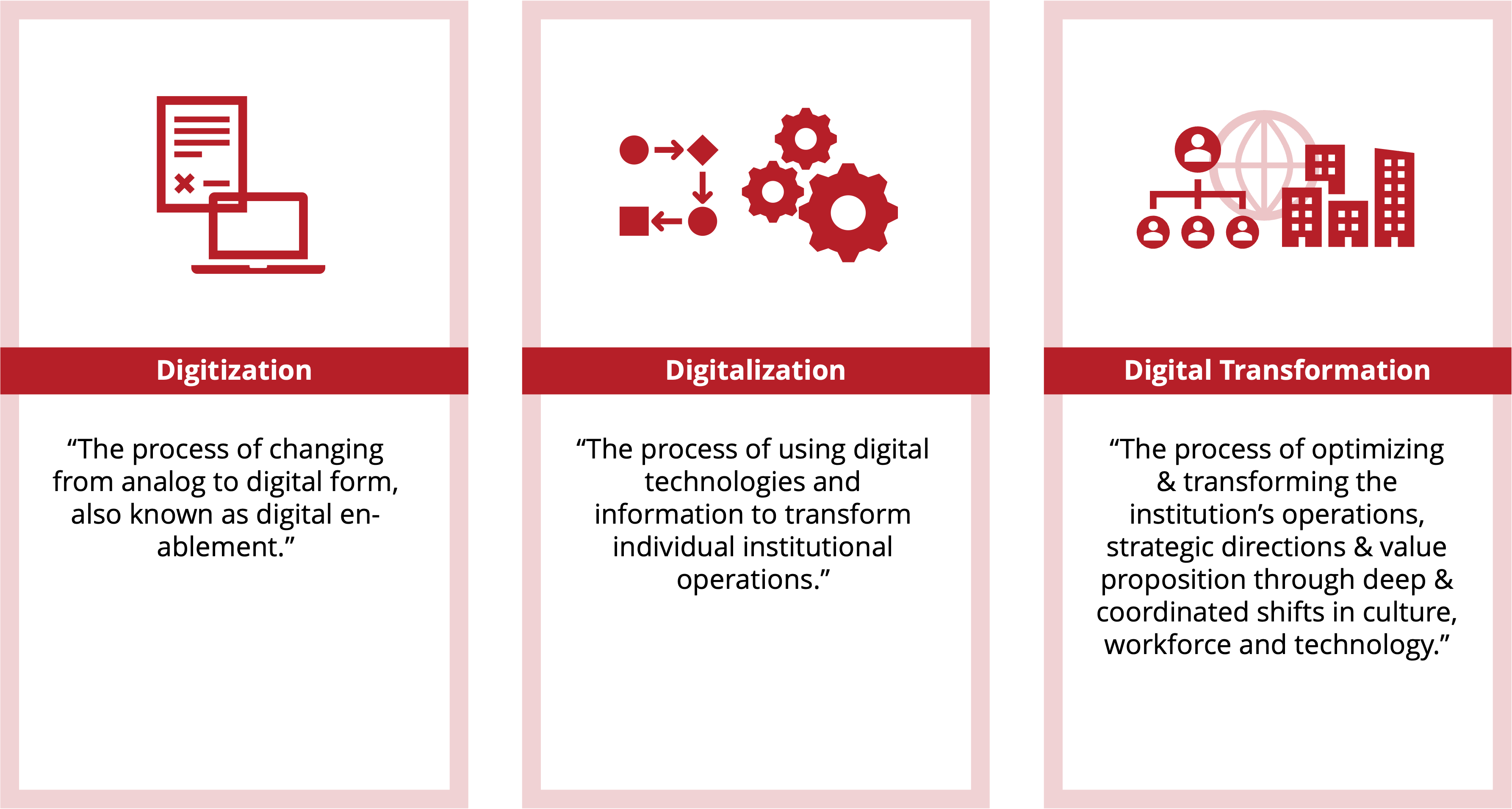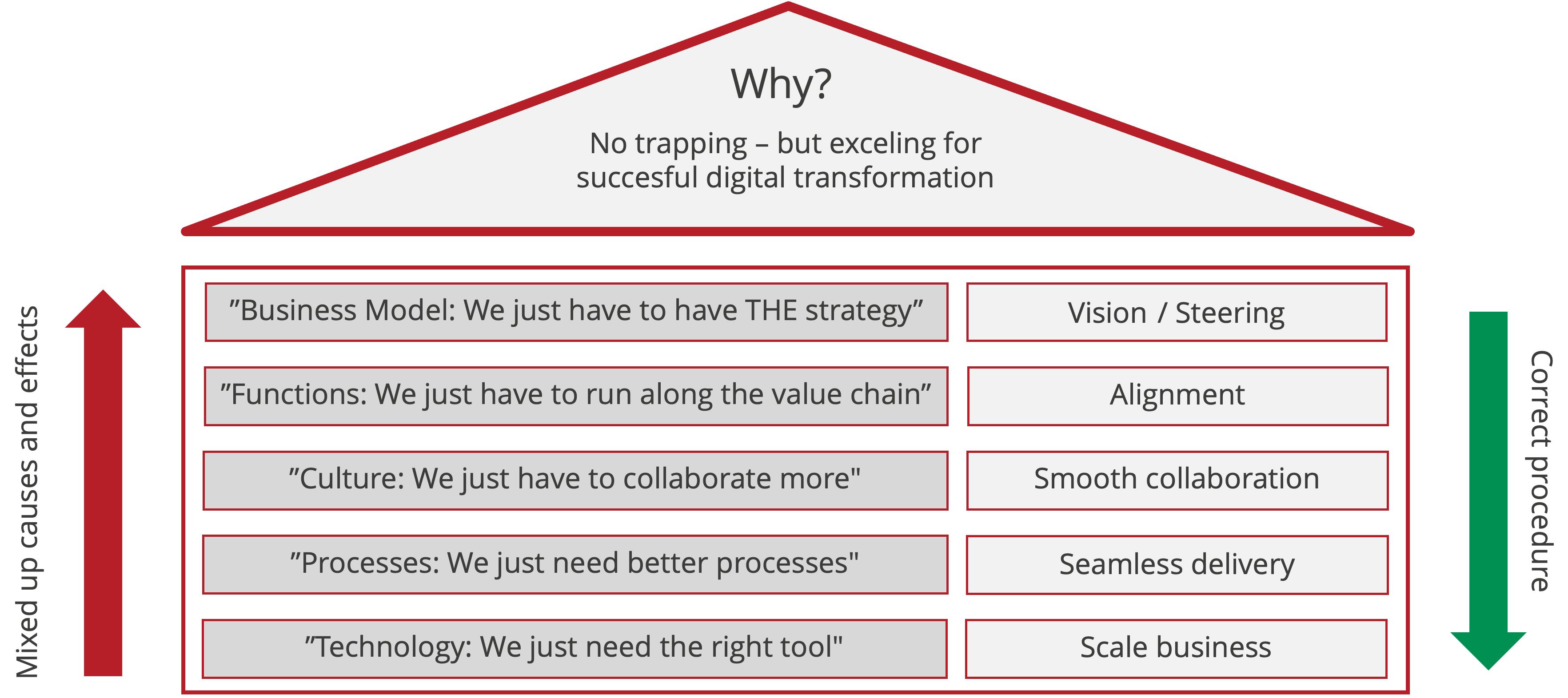Table of Contents
Today’s business leaders are confronted with numerous existential challenges, of which digital transformation is among the most pressing to leverage on the chances and stay competitive. This paper is designed to support CEOs, COOs, CIOs, and decision makers with best practices and thought leadership to create and implement digital transformation.
In the digital landscape, it is easy to get lost in the nuances between digitization, which involves the conversion of analog data into digital formats, and digitalization, which represents the broader integration of digital technologies into existing processes; while digital transformation is the profound, strategic shift in business models and operations to leverage digital capabilities for innovation and growth. Leaders and organizations are often missing out on the latter aspect – the holistic transformative approach – and just focus on technology. Accordingly, transformation is thus commonly tackled from the IT perspective, instead of business-wide and from the top.
1 | The Challenges of Digital Transformation: Understanding the Reasons for Frequent Failures
Yet, despite this obvious business need, according to Deloitte, 70% of transformative actions fail.¹ To better understand this high failure rate, we must take a closer look at the underlying challenges. In general, typical digital transformation initiatives exhibit, among
other issues, (1) a lack of clear strategy by approaching it like a simple IT project, (2) poor choice of technology, (3) inadequate leadership, and (4) intra-organizational resistance to change. They have common root causes: (1) Mixing up the terms of digitization, digitalization and digital transformation and thus having wrong expectations and the psychological phenomena of (2) hindsight bias and (3) urge for action. To not mix up the different terms of digitization, digitalization and digital transformation, it is necessary to differentiate between them (see Figure 1).
Digitization is the process of changing from analog to digital form, also known as digital enablement.²
Digitalization is the process of using digital technologies and information to transform individual institutional operations.³
Digital business transformation is the process of optimizing & transforming the institution’s operations, strategic directions & value proposition through deep & coordinated shifts in culture, workforce and technology.⁴

2 | The Solution: Designing the Digital Transformation Holistically and Strategically
The solution is to widen these narrow views to encompass the holistic picture and work on digital transformation.
Coming back to the Covid19 example:
Looking at the whole picture, humans wanted to fight the virus. For that it was necessary to look at the situation as a complex challenge that could not be grasped completely yet, because only then interventions from different dimensions could be started such as mitigation interventions, information campaigns and vac- cine invention. And this approach has to be transferred to the digital journey as this is also why organizations need a broader and holistic approach and cannot only focus on one dimension: Business is run holistically because only then value is created step by step for the customer, which then enables a stronger market position and growth potential.

This approach towards digital transformation is not a one- time project but a continuous change process. This underlines the importance of digital transformation and the need for applying the necessary resources and steps in the right order – as EBSC then did – changing to a forward-looking digital transformation of the business. To stay on the course, it is crucial to focus on the following five dimensions (see Figure 3) (to learn more from the angle of adaptiveness see our Whitepaper on the five practices for adaptive IT governance):
1. To create a business model that leverages digitalization and the latest technological advances to make customers, partners and employees fully benefit.
Starting with the vision for the future, it is necessary to fundamentally question the current business model and find a new target picture that takes full advantage of today’s technology opportunities.
2. To adapt the functional organization that runs its service delivery along the value chain.
Based on this, organizations can derive the functional organization to run the changes, projects, continuous improvements, and services to deliver maximum value.
3. To introduce an empowered culture that benefits from collaboration and knowledge across functions.
Without people who move with the management it would all be nothing. It is thus necessary to set the frame towards a collaborative culture to empower people and boost capabilities across functions.
4. To design seamless processes that provide all services end- to-end in operational excellence.
For a focus on value for the employees to notion their efficacy it is necessary to not implement processes that work against value creation (such as rigid control processes). There is thus a need for seamless processes that enable employees to provide operational excellence and eliminating duplications, rework, and unnecessary work.These steps imply the necessary technology – the technology just follows concludently and then, the digitalization itself is just a technical task:
5. To implement the latest technology that enables, extends, and scales up all business.
Technology is to support in doing business, e.g., to interconnect and leverage business.

For very good reasons John Doerr (the inventor of Objectives and Key Results) says: “Ideas are easy. Execution is everything.”⁶ This raises the remaining question of how to realize the new digital business model. The following will give a guideline through the five dimensions.
3 | The Execution: Implementing the Five Operational Dimensions
Modern business model
At this stage in the process of digital transformation EBSC restarted and envisioned to now include business customers to their customer base and to their business model. To this point, they have had only experience with and were only serving end customers. To make this scaling possible, EBSC made all products available and personalizable on a new digital customer platform besides their existing local stores.
Functional organization
An integral part is to align the requirements of all stakeholders across functions first. The requirements of the various departments are collected transparently, contradictions and overlaps eliminated, harmonized and optimized in view of the new technological possibilities. This creates a completely new service catalog and companies then get an overview of what is being done and how. Based on the service catalog all roles and responsibilities get clarified to avoid both friction and overlap. Each service is done by only one center of excellence functionally company wide and each service is represented by just one face to the internal or external customer. Qualitative and quantitative key performance indicators are implemented to get an overview for decision-making.
It is thus necessary to focus specifically on employees’ perceptions. Although the new functional organizational structure is introduced top-down in accordance with the new target picture, it should be designed in detail together with the employees. Initially, all relevant departments and people are invited to cross-divisional workshops, regardless of the hierarchical organizational structure that still formally applies. In these workshops, the service catalog from before is refined. All services are rigorously viewed from the customer‘s perspective and the best form of service delivery is co-created. Now, the focus is on the operationalization of the business model. The business model is the idea and the plan. The execution then takes place in the implementation of the appropriate functional organization.
Collaborative culture
These are preconditions to get away from vertical silo-thinking to smooth collaboration across functions. With fears involved, it is necessary to focus and concentrate on using digital transformation wisely and to help managers and employees create value, support them with resources and capacities and not throw too much demand at them and not threat them with performance pressure. The decision on the topics to work on is also a decisive one: It is helpful for leaders, managers and employees to see and work on something that produces pain already, as this shows the necessity of the actions and work.
When noticing that transparency makes performance visible and this is followed by appreciation and self-efficacy feelings, this is motivating and to humans pulling forward themselves. Another way to include employees’ motivation is to co-create solutions across all relevant functions. When employees are empowered, are given ownership and responsibility, they are willing to spend their time, effort and enthusiasm. They are allowed to decide all details and to make mistakes. Undesirable developments must be addressed openly and corrected with great appreciation of the attempted solution by the respective employees. Employees should therefore not feel like losers, but rather like active designers who make corrections and are supported by their manager with trust and experience. EBSC management did exactly that, they shared their vision of a best-in-class digital customer platform. This led to the EBSC team feeling fully empowered to develop it in an agile way, sharing each new feature transparently across the organization and even testing it with selected clients. The old-fashioned mustiness gave way to a modern spirit of optimism and even the works council likes it.
The efforts outlined are worth it. It often exceeds all expectations how powerful an organization becomes when a digitally scalable strategy and a functional and collaborative way of working are successfully combined. Without any doubt, this culture boosts modern collaboration and fosters digital transformation.
Seamless processes
Scalable technology
EBSC pursued exactly this strategy: the ERP system followed the new service catalog and was expanded into a strategic platform that supports all core business processes, connects suppliers via modern interfaces and – most importantly – is directly linked to the digital, scalable customer platform. Numerous previous individual solutions and all manual workarounds were eliminated. The successful approach is to not get trapped in the vast variety of technology options but, as the steps before changing the perspective from a digital tool to digital opportunity drivenness and thus let the technology follow concludently from the business needs.
4 | The Essence of Digital Transformation
This paper was intended to assist CEOs, COOs, CIOs, and decision-makers by offering best practices and thought leadership for digital transformation. Faced with fierce market and business challenges, having a clear view and strategic view towards digital transformation is of utmost importance. Often, the focus solely lies on technology and IT, neglecting the holistic transformative approach. Yet, the path to successful digital transformation includes:
1. Answering the question of why: Digital Transformation is no end in itself.
It all begins with a visionary digital strategy rooted in the customer‘s perspective. Digital transformation is particularly worthwhile when the business model is perfectly enhanced to benefit from new technological opportunities.
2. Answering the question of what: Digitalization alone falls short.
Effective transformation requires a 360° design of the business model, organization, culture, processes, and technology – all seamlessly along the value chain. You must therefore implement all five operational dimensions shown.
3. Answering the question of how: Modernization needs inner approval.
Co-creation and agile implementation, executed in a cross-divisional, step-by-step, and transparent manner, are crucial in this process. Ultimately, the responsibili- ty lies in carrying out the work and executing the digital transformation.
References:
¹ Clayton-Ball, Tim; Norman, Mike; King, Adam; Sloan, Peter; Vaghani, Hima; Arthur, Dunstan (2020): “Digital Transformation – Are people still our greatest asset?”, https://www2.deloitte.com/content/dam/Deloitte/uk/Documents/about-deloitte/deloitte-uk-digital-transformation-are-people-still-our-greatest-asset.pdf
² Gartner Glossary (2023): “Digitization”, https://www.gartner.com/en/information-technology/glossary/digitization
³ Connamix (2023): “Digitization, Digitalization or Digital Transformation?”, https://connamix.com/digitization- digitalization-or-digital-transformation/
⁴ Ebd.
⁵ Kahnemann (2012): “Thinking, Fast and Slow”, Penguin
⁶ Doerr, John (2018): “Measure What Matters: The Simple Idea that Drives 10x Growth”, Penguin
Related Links:
Whitepaper: BeeCore: The Principles of a Fast Execution.”
Whitepaper: “BeeCore: Five Practices for Adaptive IT Governance”
About the Authors

Dr. Julia Schreier
Alex Betz

